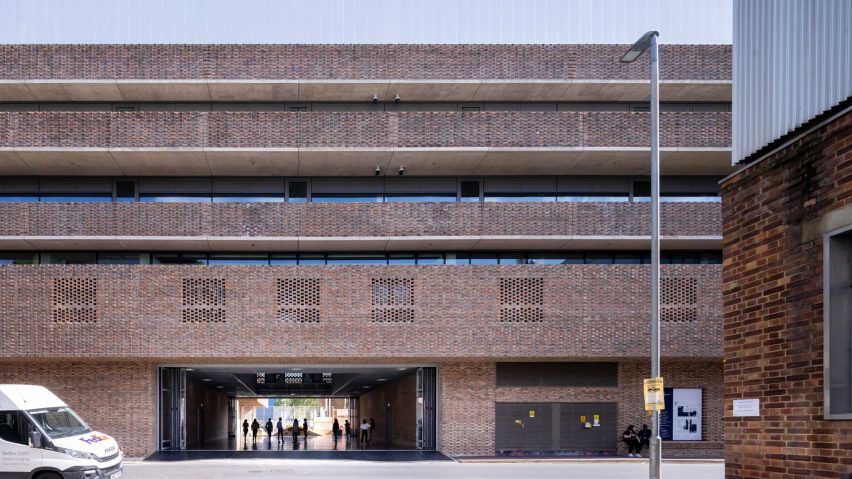Tactile brown bricks, flexible teaching spaces and public walkways animate the research and studio building that Swiss studio Herzog & de Meuron has created for the Royal College of Art in London.
Located in Battersea, the multi-storey complex supports the postgraduate art and design university's transition into science, technology and engineering.
Herzog & de Meuron's goal for the addition was for it to be modest and traditional in its aesthetic, but to enliven it with adaptable and publicly-accessible spaces.
This ensures that the building visually and physically connects with the neighbourhood while accommodating the changing needs of the university now and in the future.
"Using the brick, [the project] has a flavour of tradition and even maybe modesty," reflected the studio's founder Jacques Herzog during a tour of the building on Monday.
"At the same time, it has this need and ambition to be open for collaboration to share space, to come together, to be open to the street," Herzog told Dezeen. "This is so important, to tell the people around and the neighbourhood who you are and what you do and to let them in."
The building, first revealed in 2016, comprises 15,500 square metres of workshop, studio and research space engineered in collaboration with international engineering firm Mott Macdonald.
It is described by the Royal College of Art (RCA) as "the most significant campus development in its history" and was realised in part by a grant of £54 million from the government.
The new building can be divided into two wings, one containing studios for the university's traditional arts and design disciplines and the other for its science, technology, engineering, and maths (STEM) departments.
At their heart is The Hangar – a double-height atrium encompassing 350-square-metres that can be used for everything from lectures to exhibitions.
The atrium is flanked by large fire-station doors and linked to public walkways that intersect the building.
Herzog & de Meuron designed these passages to allow the public to enter and walk through the site, "reopening" the original Victorian street grid that once defined it.
On the studio side of the building, there are four storeys of workshops. These spaces are largely open in plan, catering for "creative transfer and collaboration" as well as temporary exhibitions and large-scale works.
The floors of these levels overhang, providing covered walkways and balconies.
This part of the building is wrapped by tactile stock brick with a flemish bond and crowned by a factory-like sawtooth roof.
The roof, which is supported on slender white steel columns, echoes the adjacent Dyson and Woo buildings on the campus.
Perforated areas within the brick walls are backed by openable windows that provide ventilation, while picture windows offer glimpses into the workshops from the street.
The brickwork contrasts with the futuristic metallic facade of the adjoining research areas in the building, which are covered in recycled-aluminium fins.
Named the Rausing Research & Innovation Building, this portion of the complex contains eight floors of research space for subjects including materials science, soft robotics and advanced manufacturing.
Many of these spaces are private and confidential, but the top floor is designed as a large conference facility for use by the college and its external partners.
Another highlight of this side of the building is the Robotics Hangar – a gallery space for testing a wide range of robotics and developments in design engineering.
"[Herzog & de Meuron has] given us the most perfect stage for the kinds of experimentation that we know the RCA does best," the university's vice-chancellor Paul Thompson told Dezeen.
"There's some 550 students from wildly different backgrounds and disciplines who will work here alongside research fellows and faculty, a prospect which we find truly exciting."
Building services are exposed and hung from the ceiling to prevent students from hitting them with angle grinders or drills while working on their projects – a problem which the university has encountered in its other buildings.
Many of the interior furnishings pay homage to alumni of the RCA. Selected in collaboration with fit-out designer LTS Architects, this includes Vitra furniture such as the Tip Ton chair by Barber&Osgerby and the Sam Son Chair for Magis by Konstantin Grcic and wayfinding by the university's former graphics tutor Margaret Calvert.
The building is designed to be passive and low-energy and is complete with a south-facing solar array that contributes energy to the building. Thermal mass from the exposed concrete superstructure also contributes to heating and cooling the building.
It has achieved BREEAM Excellent, which is the sustainability performance framework BREEAM's second-highest rating.
Herzog & de Meuron is a RIBA Royal Gold Medal and Pritzker Architecture Prize-winning studio established in Basel in 1978 by Herzog and Pierre de Meuron.
The studio fought off competition from a shortlist of six other studios, including Diller Scofidio + Renfro and Studio Gang, to win the contract.
Elsewhere in London, Herzog & de Meuron has designed the Tate Modern and its recent textured brick extension, as well as the Laban Dance Centre, which is best-known for its polycarbonate and glass facade.
The photography is by Iwan Baan.
Dezeen is on WeChat!
Click here to read the Chinese version of this article on Dezeen's official WeChat account, where we publish daily architecture and design news and projects in Simplified Chinese.

